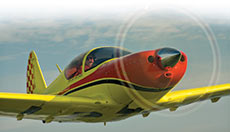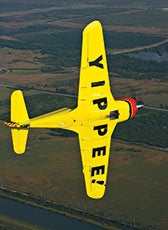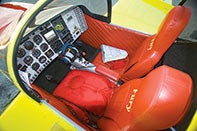YIPPEE: Evolution Of A Thoroughbred
Nearly a quarter of a century in gestation, the LoPresti Fury flies into the 21st century full of promise
 |
Roy LoPresti was one of those people who should have been allowed to live forever. I was proud to call Roy a friend and mentor, the smartest man I ever met on the subject of little airplanes.
LoPresti could have written Encyclopaedia Britannica's chapter on aerodynamics, but he probably wouldn't have bothered, as Roy's grasp of the laws of flying was far beyond conventional wisdom. He thought so far outside the box, he didn't even know there was one. He seemed to have a natural instinct for what works and what doesn't. Sadly, Roy left us six years ago, and the world of aviation became a far smaller place.
Fortunately for the rest of us, Roy's legacy is very much alive in the LoPresti Fury. Wife Peggy and sons Curt, David and Jim have been quietly continuing the LoPresti Fury project from the family's mod business, LoPresti Speed Merchants (www.speedmods.com), headquartered in Vero Beach, Fla.
The one and only prototype LoPresti Fury has been flying now for 20 years. When it burst upon the scene in the late '80s, the first and only product by the LoPrestis and Piper Aircraft Engineering, the LoPresti Fury was otter-sleek and beautiful, a charismatic aluminum nymph with an elfish demeanor and bumblebee performance.
The airplane was basically a work of art. Aerodynamicist Roger Hoh was called in to help with the design, and Hoh made a number of recommendations to improve what was already a slick, clean machine. Hoh suggested a higher, longer tailwheel to lower the airplane's three-point ground stance for better landing characteristics. He also endorsed stall strips in place of the old wing slots to even the stall. The finished product was outstanding, both in aesthetics and flight characteristics, and it inspired nearly everyone who saw it to say, "I want one."
The LoPresti Fury was dedicated to the premise that personal airplanes can be pure fun, not just intended for transportation. When it premiered at Sun 'n Fun in 1989, the LoPrestis took 131 orders (with deposits) in one week, and eventually, the order backlog rose to more than 500.
 |
Regrettably, LoPresti-Piper, a short-lived coalition between the LoPrestis and then--Piper owner Stuart Millar, wasn't to survive Piper's 1991 bankruptcy. Lots of sky has passed beneath the wing since that introduction, and the LoPresti Fury has only benefited from the delay.
Roy and his sons made a number of notable improvements in the interim. The cowling was totally redesigned for better cooling and reduced drag, something the LoPrestis know quite a bit about. Speed Merchants' cowlings for Mooneys, Pipers and Grumman-Americans are famous for their heat suppression, aerodynamic cleanliness and improved aesthetics.
 |
The original tailwheel was modified even further to a configuration similar to that of a Grumman Bearcat, snuggling up inside the tailcone out of sight when the gear is retracted. The exhaust system was slicked up to minimize drag and reduce back pressure. Finally, the modern, curved instrument panel is 20 years removed from the original. It has practically no resemblance to the 1988 version.
The bottom line is an airplane so well-conceived, utterly balanced and in tune with the pilot that it blows away nearly everything else in or out of its class. The LoPresti Fury features flush riveting all around; fully gap-sealed ailerons and flaps; a wing repositioned four inches forward for optimum speed and ground handling; a customized sliding canopy designed to reduce drag to a minimum; an airfoil with no twist; plus about a thousand other aerodynamic tricks, all intended to produce the best speed and optimum handling.
With help from aviation enthusiast and former Apple executive R.J. Siegel, the LoPrestis have pushed forward plans for a development facility in Sebastian, Fla., and hope to start work this year on an assembly plant in New Mexico. By the time you read this, LoPresti's Sebastian facility should be up and running, assembling the first of three production prototypes.
 |
I flew the one and only LoPresti Fury shortly after its first flight in the late '80s, and since then, I've flown it twice more, most recently at 2008 Sun 'n Fun in Lakeland, Fla., with LoPresti pilot Corkey Fornof. Fornof is an excellent choice as a demo pilot; he's an air show expert and a motion picture aerial coordinator whose work includes two decades of flying in dozens of movies, everything from a trio of James Bond films and Mission: Impossible II to Jurassic Park and Congo. Fornof also worked with me on an '80s ABC-TV series, Wide World of Flying.
Fornof has flown a variety of airplanes in conjunction with his motion picture and television work, and he analogizes the LoPresti Fury straight across to a WWII fighter. "Obviously, it's smaller and not as fast, but the handling is remarkably similar," says Fornof. "Roy designed the LoPresti Fury with fighters in mind. He was determined that his airplane would pay more than lip service to the military HOTAS principle---hands on throttle and stick."
That's especially important for fighter pilots who must maneuver and manipulate aircraft and weapons systems simultaneously. It's just pure fun for those of us in general aviation. Collectively, the stick and throttle house switches for flaps, speed brakes, push to talk, trim, autopilot disconnect, landing light, transponder ident and more.
Unlike most fighters, which house their single- or two-pilot crew in a small enclosure out on the pointy end (or in tandem cockpits for two), the LoPresti Fury seats its pilots side by side. A single throttle is mounted at the center panel. If you're a former military aviator (or wish you were), the most logical place to fly the LoPresti Fury prototype is from the right seat, where the stick falls naturally to your right hand and the throttle to your left. Production LoPresti Furies will be configured with an optional second throttle on the left sidewall, so either pilot can fly with right hand on stick and left hand on throttle.
 |
With thousands of hours in WWII fighters, primarily Mustangs and Bearcats, Fornof suggests the LoPresti Fury design is about as close as you can come in general aviation to those famous fighters. "Okay, so you're not flying behind a Merlin or a Pratt & Whitney. The feel is still military, but with civilian comfort," he asserts. The airplane also sports aerobatic chops in keeping with its slick design. The LoPresti Fury isn't an ultimate aerobatic hot dog like the Extra or Pitts, but it does maneuvers with the aplomb of a Mustang. In many ways, it's more similar to a warbird than to a two-seat Mooney or Bonanza.
The LoPresti Fury strikes that happy balance of mini-fighter and casual sportplane, acro "funster" and long-distance cruiser. In campaigning the airplane on the air show circuit around the country, Fornof often flies strapped into his parachute to provide occasional 3D en route distraction.
Roy felt the ultimate litmus test for an airplane was handling and control harmony. As much as Roy loved speed (he drove a Ferrari), he was adamant that if an airplane didn't manifest excellent handling, all the other parameters---climb, cruise, service ceiling, short-field characteristics---were irrelevant.
 The LoPresti Fury will come standard with a full Bendix/King panel and a unique TaxiCam feature, a forward-looking video camera mounted on the right wing root that checks for traffic ahead, both on the taxiway and in the sky. |
Roy was passionate about handling, and it shows up from the moment you push the throttle forward. It just doesn't get much better than the LoPresti Fury. With the help of push rods and roller bearings at every juncture, the LoPresti design handles almost intuitively. Think a maneuver, and the LoPresti Fury glissades through it with the larking, capering agility of Barishnikov on speed. It's almost as if the airplane is psychic, reading your thoughts and anticipating your next move.
Accordingly, the LoPresti Fury will be approved for aerobatic maneuvers like loops, Cuban eights, the gamut of rolls (slow, point and barrel), hammerheads, Immelmanns, spins and split Ss. These are essentially the same maneuvers normally performed in warbirds, and Fornof suggests the LoPresti Fury does them with equal dispatch, if at lower speeds. G-limits are +6/-3, so the airplane can take more than most of its pilots.
Like the Marchetti's near-telepathic response, the LoPresti Fury's agility is somewhere between excellent and purely sensuous. The airplane's ability to challenge the vertical and inverted sky is about as good as it gets. The prototype I flew frolicked behind a standard 200 hp Lycoming IO-360 mill. With 2,300 pounds to lift, that provides plenty of enthusiasm, but at this writing, it's uncertain if that will be the production engine. There's some talk of a Continental IO-550, probably rated for 310 hp. That would make quick work of the airplane's fuel supply (current capacity on the prototype is 40 gallons, but the wings can accommodate up to 74 gallons), allowing only about 2 + 45 plus reserve at max cruise.
The big engine would also produce a screamer in both climb and cruise. Ascent with the IO-550 would probably top 2,000 fpm, and a 310 hp LoPresti Fury would almost certainly be a 200-knot airplane, probably easily the equal of a Mooney Ovation in cruise.
 Unlike most of the fighters it's designed after, the LoPresti Fury seats its pilots side by side in the cockpit. A single throttle is mounted at its center panel. |
Even in its current form, the LoPresti Fury is no slouch in either category. Pulled nose high at 85 knots for the best climb rate, the LoPresti Fury charges uphill as if its tail is on fire, scoring an initial 1,350 fpm. In the LoPresti tradition, cruise is remarkably efficient, the result of a conscientious attempt to slick and fair wherever possible.
At a time when avgas costs more than reasonably priced Chablis, the LoPresti Fury is an efficiency expert. The completely flush-riveted prototype cruises at an easy 180 to 185 knots, burning 10 to 11 gph. That's almost 19 statute mpg, about as good as my four-year-old Infiniti. If the airplane is produced with 200 hp, fuel will probably jump to 66 gallons, so the LoPresti Fury should offer five hours plus reserve at high cruise, worth about 900 nm between pit stops.
As one of a mere handful of certified taildraggers available, the LoPresti Fury doesn't manifest the sometimes nasty habits you associate with the type, especially in landing mode. Gear doors that close over the wheel wells with the gear down help assure docile manners when the rubber meets the runway.
Way back in a previous life, I logged a few thousand hours in a succession of conventional-gear machines, but my recent time in taildraggers has been extremely limited. On the flight with Fornof, I didn't break anything or hurt myself. If an aviation writer can do it, anyone can.
At a base price of $355,000, production LoPresti Furies will come standard with a full Bendix/King panel including virtually everything most aviators will want. In addition to the usual VHF/GPS/NAV/COM, the LoPresti Fury will sport a Mode S transponder along with TIS uplink, TAWS, XM Weather capability, a built-in iPod and TaxiCam, the latter a feature unique to LoPresti. (It's a forward-looking video camera mounted in the right wing root to check for traffic ahead, both on the taxiway and in the sky.)
The LoPresti Fury's only direct competition is the Micco SP26A, a 260 hp modernization of the Meyers 145 that's also great fun to fly but not quite as quick. Like the LoPresti Fury, the Micco is rated for limited aerobatics and sells for roughly the same price. [See "Micco SP26A: Capable Aerobat" from P&P December 2007.]
If everything goes according to plan, the LoPrestis hope to roll out the first production LoPresti Fury in about two years, so plan to see a happy owner fly away from the New Mexico plant in late 2010 or early 2011.
Personally, I'm negotiating a deal to buy the prototype once the airplane enters production. Curt LoPresti, president of LoPresti Speed Merchants, has suggested that he just might let me have it for cost.
SPECS: LoPresti Fury

Subscribe to Our Newsletter
Get the latest Plane & Pilot Magazine stories delivered directly to your inbox





